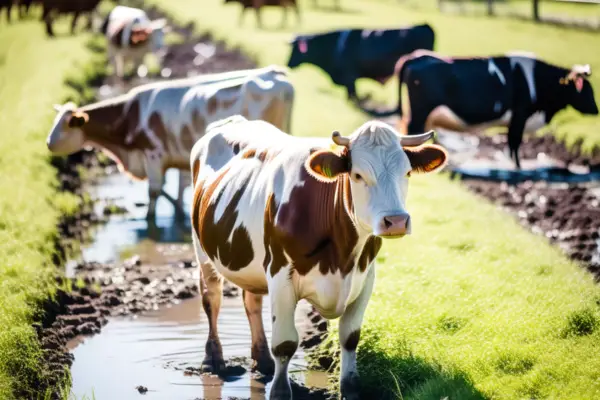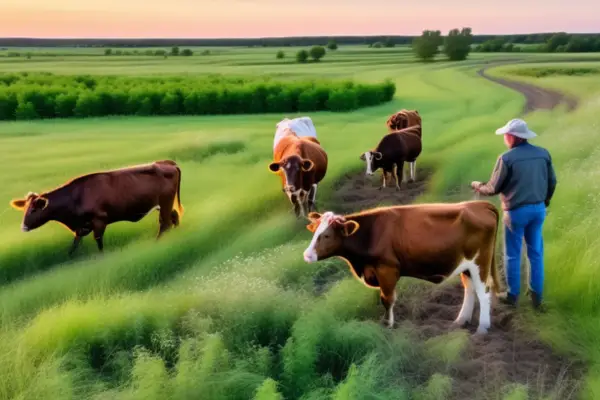Implementing a sustainable grazing system for cattle is important for every environmental and monetary causes. Overgrazing may end up in soil erosion, lack of vegetation, diminished biodiversity, and full land degradation over time. Furthermore, poor grazing administration usually ends in lower weight constructive components for cattle and diminished earnings for ranchers.
Nonetheless, with cautious planning and administration, it is doable to develop an optimized, regenerative grazing system that improves soil and plant efficiently being whereas supporting healthful, productive livestock.
The keys are controlling timing and depth of grazing, promoting vegetation restoration durations, and utilizing devices like fencing and water stage distribution.
Assess Current Sources
Step one is taking stock of your current pastures, grasses, water sources, fencing, and one totally different infrastructure. Stroll the land and make notes on the subsequent:
- Pasture measurement, type, terrain
- Forms of current grasses and forages
- Prevalence of desired species to your native native climate and cattle operation
- Areas of overgrazing or weed infestation
- Location of shade, pure windbreaks, and water sources
This analysis helps inform your grazing efficiency for land all by the use of diversified seasons whereas determining any enhancements wished.

Implement Rotational Grazing
Rotational or managed intensive grazing packages dividing pastures into quite a few paddocks that cattle rotate by means of on a deliberate schedule. Normally, paddocks allow 1-15 days of grazing adopted by 25-90 days of rest and regrowth.
Benefits of rotational grazing embody:
- Additional even manure distribution, enhancing pure matter and dietary dietary nutritional vitamins in soil
- Longer rest durations, allowing crops to regrow stronger roots and leaves
- Elevated grass manufacturing and carrying efficiency over time
- Larger administration over timing of grazing based utterly on plant progress ranges
To implement rotational grazing, put together electrical fencing or divide current pastures with eternal fencing to create paddocks of equal grazing price. The optimum paddock amount relies upon upon upon the dimensions of your operation nonetheless often ranges from 8 to 12 separate areas. Observe cattle actions using a grazing chart that outlines the rotation schedule and restoration durations for each house.
Improve Forage Prime quality
Overview the sorts of current grasses and forages in your pastures. Determine if any modifications ought to be made to you must undoubtedly have productive, resilient species well-suited for grazing in your native native climate and soils. This may increasingly an rising variety of embrace:
- Overseeding less-productive areas with improved or native forage species
- Weed administration and administration
- Soil testing and making use of any wished soil amendments like lime or micronutrients
- Planning fertilizer capabilities spherical grazing rotations to steer clear of overgrazing lush new progress
- Incorporating legumes like clover into cool-season grasses to chop as soon as extra need for nitrogen fertilizers
Elevated-quality, assorted forages translate to greater cattle constructive components and pasture resilience whereas reducing supplemental feed needs.

Deal with Stocking Fees
Base the number of cattle grazed on the final word productiveness of the land each season, expressed as animal objects per acre. This stocking price determines in case you’re overgrazing or underutilizing accessible forages. Search steering from agricultural extension property to set sustainable stocking expenses in your space.
Be able to deal with as wished by having fallback paddocks to maneuver cattle into in intervals of sluggish forage regrowth. Lighter stocking presents crops sufficient restoration time between grazing events. Make reductions in case you uncover declines in pasture high-quality, uncovered soil, influx of weeds, or poor cattle widespread day-to-day constructive components.
Current Sufficient Water Sources
Cattle need fixed entry to clean consuming water. Plan water parts like tanks, troughs, or pure water our our our our bodies to fall inside 800 ft of grazing paddocks when doable. Preserve in any case one water current for every 50-75 head of cattle. Space water parts in any case 400 ft apart to promote even grazing distribution moderately than concentrated areas surrounding a single current.
Overview location options yearly and regulate as wished based utterly on observations of cattle movement, grazing patterns, and erosion parts.
Use Low-Stress Livestock Coping with
The perfect method cattle are moved between paddocks can affect soil compaction and vegetation trampling if not executed exactly. Implementing low-stress livestock coping with methods promotes calmer cattle movement whereas reducing safety risks for every handlers and animals.
Strategies embody:
- Clear marking of entrances and exists
- Creating funnel-shaped paddock layouts
- Benefiting from cattle’s pure circling instincts
- Using educated herding canines or horses
- Positioning people on the as quickly as further to provide stress from behind
Keep away from electrical prods or yelling. Change cattle slowly and quietly in established routes between paddock gates to assist soil conservation.
Monitor and Adapt
Persistently monitor your grazing system, forage high-quality, soil efficiently being, and cattle physique state of affairs. Hold detailed info that uncover grazing interval and depth inside each house, rest durations, rainfall, temperature patterns, and any modifications made.
Overview info and visually study pastures every all by the use of and post-grazing. Any parts with diminished plant vigor, uncovered soil, erosion, or poor cattle effectivity alerts modifications are wished.
Have the power to rotate cattle sooner, additional within the discount of stocking expenses, reseed bare areas, or current cattle supplemental forage all by the use of prolonged native local weather extremes. A sustainable grazing system ought to be resilient to seasonal variability.
Closing Phrases;
Implementing these regenerative grazing practices takes dedication nonetheless pays off in further healthful soils, forages, cattle, and elevated ranch profitability over the long term.
Modify and refine based utterly on proof to your environment whereas specializing in maximizing pasture rest durations and soil security each time doable. With shut administration and monitoring, cattle might very correctly be raised in symbiosis with grassland ecosystems.


